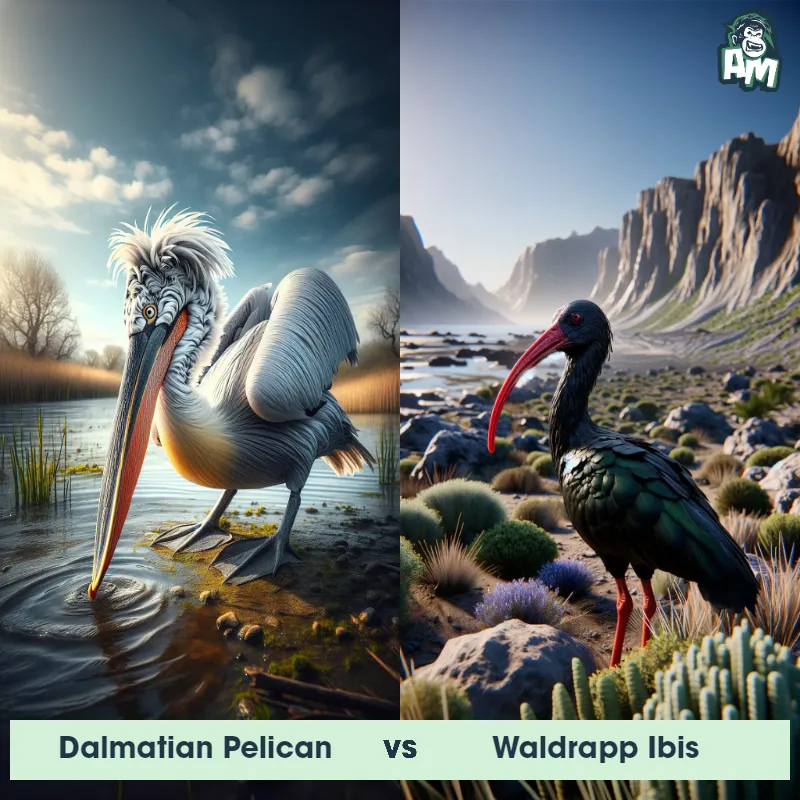The Waldrapp Ibis
The Waldrapp Ibis, also known as the Northern Bald Ibis, is a species of bird belonging to the ibis family. These birds are medium-sized, measuring around 70 centimeters in length and weighing approximately 1 kilogram. They have a distinctive appearance, with their bald, reddish-brown head and neck, black feathers, and long downward-curving beak. The Waldrapp Ibis is known for its characteristic breeding behavior, where pairs engage in synchronous head-bobbing displays. They primarily inhabit rocky, arid regions and are known for their strong flying abilities.

| Waldrapp Ibis | |
|---|---|
| Size | Approximately 110 cm (43 in) tall |
| Weight | Approximately 1.5 kg (3.3 lbs) |
| Speed | 30mph (48km/h) |
| Key Strength | Agility and beak strength |
| Biggest Weakness | Lack of physical aggression |
| Scientific Name | Geronticus eremita |
| Family | Threskiornithidae |
| Habitat | Mountainous regions, cliff ledges |
| Geography | Europe, North Africa, Middle East |
| Diet | Insects, grubs, small invertebrates |
| Lifespan | 20 years - 25 years |

The Waldrapp Ibis
The Waldrapp Ibis, also known as the Northern Bald Ibis, is a species of bird belonging to the ibis family. These birds are medium-sized, measuring around 70 centimeters in length and weighing approximately 1 kilogram. They have a distinctive appearance, with their bald, reddish-brown head and neck, black feathers, and long downward-curving beak. The Waldrapp Ibis is known for its characteristic breeding behavior, where pairs engage in synchronous head-bobbing displays. They primarily inhabit rocky, arid regions and are known for their strong flying abilities.
Fun Fact: The Waldrapp Ibis is one of the rarest bird species in the world, with only a few hundred individuals remaining in the wild.
| Waldrapp Ibis | |
|---|---|
| Size | Approximately 110 cm (43 in) tall |
| Weight | Approximately 1.5 kg (3.3 lbs) |
| Speed | 30mph (48km/h) |
| Key Strength | Agility and beak strength |
| Biggest Weakness | Lack of physical aggression |
| Scientific Name | Geronticus eremita |
| Family | Threskiornithidae |
| Habitat | Mountainous regions, cliff ledges |
| Geography | Europe, North Africa, Middle East |
| Diet | Insects, grubs, small invertebrates |
| Lifespan | 20 years - 25 years |
Waldrapp Ibis Matchups
We use AI to simulate matchups between the Waldrapp Ibis and other animals. Our simulation considers size, strength, and natural predatory behaviors to determine the most likely outcome.
Waldrapp Ibis: Diet, Predators, Aggression, and Defensive Behaviors
What do Waldrapp Ibises eat?
Waldrapp Ibises primarily feed on a variety of insects, small reptiles, and other invertebrates. They use their long, curved bills to probe the soft ground for food. Additionally, they will also consume fruits, seeds, and small amphibians, making their diet quite diverse.
Do Waldrapp Ibises have any predators?
Yes, Waldrapp Ibises have several predators in the wild. Common predators include larger birds of prey such as eagles and hawks, as well as some mammalian predators like foxes and wild cats. These predators often target young or injured ibises that are more vulnerable.
Are Waldrapp Ibises aggressive?
While Waldrapp Ibises are generally not aggressive towards humans, they can display aggression towards each other during mating season or when competing for food and territory. This aggression can manifest in displays of dominance, posturing, and vocalizations.
Do Waldrapp Ibises fight?
Waldrapp Ibises may engage in physical fights with each other, especially during the breeding season when competition for mates and nesting sites is high. These fights can involve pecking, kicking, and wing-fluttering as the ibises try to establish dominance or defend their territory.
How do Waldrapp Ibises defend themselves?
Waldrapp Ibises primarily rely on their agility and speed to defend themselves against predators. When threatened, they will take flight or run quickly to escape danger. Additionally, they may use their sharp bills to peck or jab at potential threats as a form of defense.
What is the biggest weakness of Waldrapp Ibises in a fight?
One of the biggest weaknesses of Waldrapp Ibises in a fight is their relatively small size and lightweight build. Compared to larger predators or competitors, ibises may struggle to overpower their opponents physically. They must rely on their speed, agility, and strategic maneuvers to gain an advantage in a fight.
Fun Fact: These intelligent birds have the ability to recognize themselves in mirrors, a behavior that is considered an indicator of self-awareness.
Fun Fact: During the mating season, male Waldrapp Ibises woo females by presenting them with sticks or other small objects as part of a courtship ritual.
















